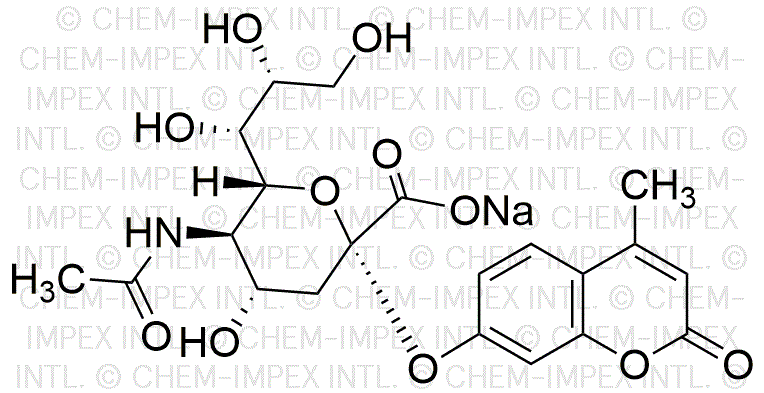2'-(4-Methylumbelliferyl)-a-D-N-acetylneuraminic acid sodium salt is widely utilized in research focused on:
- Enzyme Activity Assays: This compound serves as a substrate for sialidase enzymes, allowing researchers to measure enzyme activity in various biological samples, which is crucial for understanding metabolic pathways.
- Cell Biology: It is used in cell culture studies to investigate the role of sialic acids in cell recognition and signaling, providing insights into cellular interactions and immune responses.
- Diagnostic Applications: The compound can be employed in diagnostic kits to detect sialidase activity in clinical samples, aiding in the diagnosis of certain diseases, including viral infections.
- Biotechnology: In the field of biotechnology, it is utilized for the development of sialylated glycoproteins, which are important for vaccine development and therapeutic proteins.
- Research on Glycobiology: This chemical plays a significant role in glycobiology research, helping scientists understand the structure and function of glycoproteins and their impact on health and disease.
Información general
Propiedades
Seguridad y normativas
Aplicaciones
2'-(4-Methylumbelliferyl)-a-D-N-acetylneuraminic acid sodium salt is widely utilized in research focused on:
- Enzyme Activity Assays: This compound serves as a substrate for sialidase enzymes, allowing researchers to measure enzyme activity in various biological samples, which is crucial for understanding metabolic pathways.
- Cell Biology: It is used in cell culture studies to investigate the role of sialic acids in cell recognition and signaling, providing insights into cellular interactions and immune responses.
- Diagnostic Applications: The compound can be employed in diagnostic kits to detect sialidase activity in clinical samples, aiding in the diagnosis of certain diseases, including viral infections.
- Biotechnology: In the field of biotechnology, it is utilized for the development of sialylated glycoproteins, which are important for vaccine development and therapeutic proteins.
- Research on Glycobiology: This chemical plays a significant role in glycobiology research, helping scientists understand the structure and function of glycoproteins and their impact on health and disease.
Documentos
Hojas de datos de seguridad (HDS)
La SDS proporciona información de seguridad completa sobre la manipulación, el almacenamiento y la eliminación del producto.
Especificación del producto (PS)
La PS proporciona un desglose completo de las propiedades del producto, incluida la composición química, el estado físico, la pureza y los requisitos de almacenamiento. También detalla los rangos de calidad aceptables y las aplicaciones previstas del producto.
Certificados de análisis (COA)
Busque certificados de análisis (COA) ingresando el número de lote del producto. Los números de lote y de partida se pueden encontrar en la etiqueta de un producto después de las palabras "Lote" o "Lote".
Número de catálogo
Número de lote/lote
Certificados de origen (COO)
Este certificado de origen confirma el país en el que se fabricó el producto y también detalla los materiales y componentes utilizados en él y si se deriva de fuentes naturales, sintéticas u otras fuentes específicas. Este certificado puede ser necesario para cumplir con las normativas aduaneras, comerciales y regulatorias.
Número de catálogo
Número de lote/lote
Hojas de datos de seguridad (HDS)
La SDS proporciona información de seguridad completa sobre la manipulación, el almacenamiento y la eliminación del producto.
DownloadEspecificación del producto (PS)
La PS proporciona un desglose completo de las propiedades del producto, incluida la composición química, el estado físico, la pureza y los requisitos de almacenamiento. También detalla los rangos de calidad aceptables y las aplicaciones previstas del producto.
DownloadCertificados de análisis (COA)
Busque certificados de análisis (COA) ingresando el número de lote del producto. Los números de lote y de partida se pueden encontrar en la etiqueta de un producto después de las palabras "Lote" o "Lote".
Número de catálogo
Número de lote/lote
Certificados de origen (COO)
Este certificado de origen confirma el país en el que se fabricó el producto y también detalla los materiales y componentes utilizados en él y si se deriva de fuentes naturales, sintéticas u otras fuentes específicas. Este certificado puede ser necesario para cumplir con las normativas aduaneras, comerciales y regulatorias.


